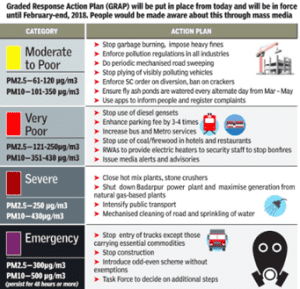TAG: GS-3: SCIENCE & TECHNOLOGY
CONTEXT: Recently, the Commission for Air Quality Management in NCR & Adjoining Areas (CAQM) has announced a revision in the existing Graded Response Action Plan (GRAP) to combat air pollution in the region.
EXPLANATION:
About Graded Response Action Plan (GRAP)?
The full form of GRAP is Graded Response Action Plan. The Supreme Court of India in M. C. Mehta v. Union of India (2016) judgement approved implementing a Graded Response Action Plan (GRAP) for Delhi and the surrounding NCR region in 2016.
- MoEF&CC notified the GRAP in 2017.
- It was prepared after multiple rounds of meetings and engagements between the Environment Pollution (Prevention & Control) Authority (EPCA), representatives of state government, and domain experts.
Implementation:
-
- From 2021 onwards, the GRAP is being implemented by the CAQM.
- Till 2020, the Supreme Court-appointed Environment Pollution (Prevention & Control) Authority (EPCA) used to order States to implement GRAP measures.
- The EPCA was dissolved and replaced by the Commission for Air Quality Management (CAQM) in 2020.
- CAQM relies on air quality and meteorological forecasts by the Indian Institute of Tropical Meteorology (IITM) and the India Meteorological Department (IMD).
- From 2021 onwards, the GRAP is being implemented by the CAQM.
- The revised action plan will be dependent on Air Quality Index (AQI) for restrictions on polluting activities rather than PM2.5 and PM10 concentration.
Type of emergency response plan that categorizes the severity of air pollution levels into four categories:

The plan outlines measures to be taken by various authorities, including the Delhi government, the Central Pollution Control Board, and other concerned
agencies based on the air quality index (AQI).
How does GRAP work?
- The plan is incremental in nature. it does not include action by various state governments to be taken throughout the year to tackle emissions.
- If air quality reaches the severe stage, GRAP talks about shutting down schools and implementing the odd-even road-space rationing scheme.
- The plan requires action and coordination among 13 different agencies in Delhi, Uttar Pradesh, Haryana and Rajasthan (NCR areas). At the top is the EPCA, mandated by the Supreme Court.
- Before the imposition of any measure, EPCA holds a meeting with representatives from all NCR states.
Government Initiatives to Combat Air Pollution?
- Graded Response Action Plan (Delhi).
- Polluter Pay principle.
- Smog Tower.
- Tallest Air Purifier.
- National Clean Air Programme (NCAP).
- BS-VI vehicles
- Pradhan Mantri Ujjwala Yojana (PMUY)
Source:
Spread the Word
